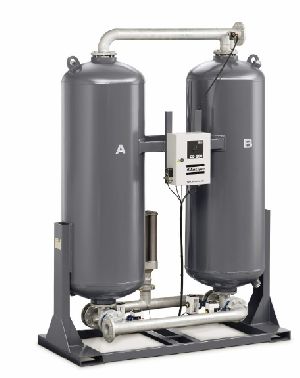
Vpsa Oxygen Plant
Country of Origin : Made in India
Application : Industrial / Medical

Psa Nitrogen Plant
The Nitrogen generation plant based on the PSA-process consist of two adsorption towers filled with carbon molecular sieve. Compressed and purified air is passing the adsorption towers. Mainly Oxygen is adsorbed by the carbon molecular sieve and Nitrogen enriched gas is leaving the tower. During adsorption in one tower the second tower is totally regenerated just by depressurization to ambient pressure. The Oxygen enriched off gas with 30-35 vol.-% Oxygen content is vented to the outside atmosphere. After about one minute adsorption in one adsorption tower the process controller is switching over to the second tower and the first one is regenerated Atmospheric air contains essentially 78% nitrogen and 21% oxygen. Ordinary dry compressed air is filtered and passed through a technically advanced bundle of hollow membrane fibers where nitrogen is separated from the feed air by selective permeation. Water vapor and oxygen rapidly permeate safely to the atmosphere, while the nitrogen gas is discharged under pressure into the distribution system. Pressure, flow rate and membrane size/quantity are the main variables that affect nitrogen production. Nitrogen purity (oxygen content) is controlled by throttling the outlet from the membrane bundle(s). At a given pressure and membrane size, increasing the nitrogen flow allows more oxygen to remain in the gas stream, lowering nitrogen purity. Conversely, decreasing nitrogen flow increases purity. For a particular purity, higher air pressure to the membrane gives a higher nitrogen flow rate. Purity ranges of less than 90% to 99.999% are possible. By combining multiple membrane bundles, an infinite number of flow/purity ranges are available to satisfy practically any application that requires nitrogen gas. PSA Nitrogen N2 Gas Generator Plant is an Inertisation Gas Atmosphere Generator ... enabling a permanent source of onsite NITROGEN / inert gas, with minimum energy consumption. PSA Nitrogen N2 Gas Generator Equipment is an Inert Gas Atmosphere Generator & incorporates Two sets of columns filled with Carbon Molecular Sieves CMS. Under Pressure these columns retain all Active Molecules compounds present in air like (Oxygen, Carbon Dioxide and Water) with the exception of the inert gases like Nitrogen & Argon.. The N2 Gas can be produced onsite for direct use or can be stored in Nitrogen storage tanks Bottles or cylinders for intermittent use. (Nitrogen and Argon). This process is referred as PSA (Pressure Swing Adsorption).
...more
Ammonia Cracker
NH3-Cracker or hydrogen generator is used for the production of forming gas. Hydrogen and Nitrogen are generated in a cost effective way. In a volume ratio of 3 : 1 or in a weight ratio of 14 : 3. Capacities from 1m3/h to 60m3/h are available. Ammonia cracking is a simple and cost effective method of manufacturing hydrogen, however it may be used only in the applications, in which presence of nitrogen is acceptable. The NH3 is coming from bottles or from or bulk tanker. The ammonia gas is pre-heated in a heat exchanger and vaporizer and then cracked in the main furnace unit. The furnace is electrically heated by special LGO heating elements. The decomposition of ammonia gas NH3 takes place at a temperature of 920°C in the presence of a special grade nickel catalyst in an electrically heated furnace. 2 NH3 gives N2 + 3 H2 The cracked gas then passes to the heat exchanger for cooling and for pre-heating the incoming gas. This way and in combination with the low power consuming LGO heating elements, it can be made sure that only a minimum of electricity has to be used for the cracking process. * Ammonia cracking is a process of dissociation (decomposition) of gaseous anhydrous Ammonia (NH3) into a mixture of Hydrogen (H2) and Nitrogen (N2) according to the reaction: 2NH3 = N2 + 3H2 * The reaction is endothemic, requiring 383 kJ/mol. The process is performed at increased temperature within the range 1560-1740ºF (850-950ºC) in the presence of special grade nickel as catalyst. The resulting gas mixture is composed of hydrogen and nitrogen in the proportion 3:1 (75% of H2 and 25% of N2) with very little amount (20 -100 ppm) of residual undissociated ammonia with dew point -60ºF to -20ºF (-51ºC to -29ºC). The gas may be further purified by molecular sieves purifier resulting in reducing the uncracked ammonia to 1-3 ppm with dew point -110ºF (-80ºC). Available Capacities. 0 m3/hour to 60 m3/hour. Salient Features * Easy to operate.* Low capital cost* maintenance free operation.* Low running cost* Available in diffrent capacities.* Long service life.* Very cost effective alternate for water Electrolysis Plants in terms of power, capital cost and running cost Applications * Annualy furnance in cold rolling industries.* For providing atmosphere in Hydrogen Bell.* For providing reduction in bulk drug.* Stainless steel wire annealing.* Continuous galvanizing lines.* Bi-metal products annealing.* Sintered products annealing.* Metal Powder annealing.* Brazing application.* Heat treatment.
...more
Air Dryers
Material : SS
Automatic : Automatic
Country of Origin : Made in India
...moreBe first to Rate
Rate ThisOpening Hours